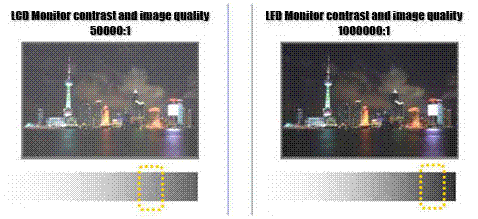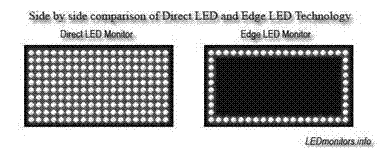LCD (Liquid Crystal Display) and LED (Light Emitting Diode) Displays are two major display technologies being widely used today. LED Displays are technological advancement of LCD displays. LED displays are the LCD displays with an LED backlight to power up the LCD panel. It means that LEDs are placed behind or around the LCD panel to enhance the luminosity and video definition of the monitor screen. Cold cathode lights are used as backlight in LCD displays. In LED displays all the concepts are same except this backlight feature, which is replaced by LEDs.
Although the major difference between LCD and LED displays is just the backlight but it also confers a number of improvements in the LED displays which are covered in the subsequent section:
Contrast: Contrast and Black level of the LED screen is better than the LCD screens because the liquid crystals cannot stop 100% of the backlight from cold cathode backlight and hence when the black screen is to be shown on the monitor, it is not completely black (as shown in the below image). But LED screens perfectly show the black screen as there is no backlight at all.

Color accuracy: Color accuracyfor direct and edge LED displays and LCD displays are almost same but the RGB LEDs display has quite better color accuracy. There are three different types of LED monitors available based on the manner how the diodes are arranges in the monitor. These are – Direct LEDs, Edge LEDs and RGB LEDs. Both Edge and Direct LED display monitors use white diodes that are used to illuminate the LCD panel to produce the improved picture quality. The arrangement of LEDs in the monitor is shown in the below image:
 Viewing Angle: If the viewing angle of the display is much wider than thirty degrees from the center then the contrast ratio of the image is diminished in LCD. This affects the eyes while this disadvantage is overcome in LED. LEDs have a wider viewing angle, which means the image is still clear when viewed from the side.
Viewing Angle: If the viewing angle of the display is much wider than thirty degrees from the center then the contrast ratio of the image is diminished in LCD. This affects the eyes while this disadvantage is overcome in LED. LEDs have a wider viewing angle, which means the image is still clear when viewed from the side.
Filed Under: How to


Questions related to this article?
👉Ask and discuss on EDAboard.com and Electro-Tech-Online.com forums.
Tell Us What You Think!!
You must be logged in to post a comment.